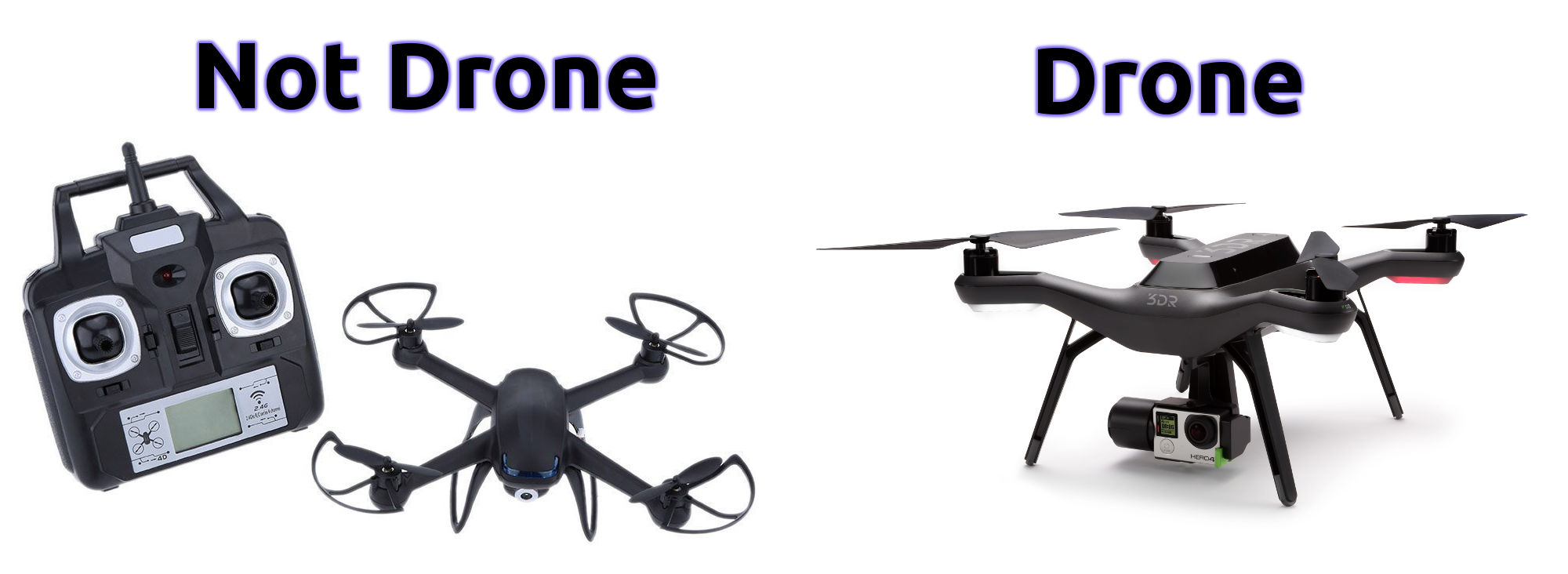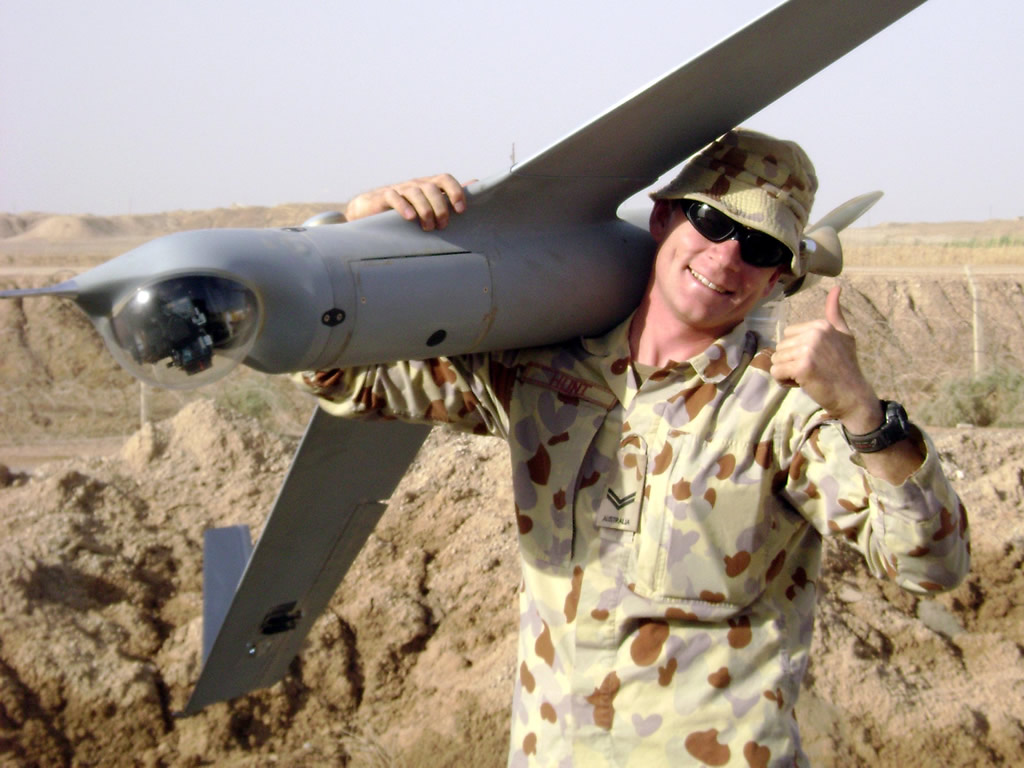#1 Not all remote controlled aircraft are drones
The rise in popularity of consumer drones has led to a considerable amount of confusion. The word drone has been misused by the media and manufacturers attempting to capitalize on the excitement that surrounds everything “drone”. A drone is a robot that has the ability to operate autonomously without direct control from a human operator.
 “Drone” usually refers to unmanned aircraft which are also called UAVs (more on that later). There are other types of drones too such as boats, submarines and ground based robots. For an aircraft to be considered a drone it must have an autopilot and have the ability to fly without user input. Many of the “drones” on the market right now do not meet that criteria. For example this is not a drone, Flymemo DM007 but it is marketed as one. This one is a drone 3DR Solo Drone Quadcopter.
“Drone” usually refers to unmanned aircraft which are also called UAVs (more on that later). There are other types of drones too such as boats, submarines and ground based robots. For an aircraft to be considered a drone it must have an autopilot and have the ability to fly without user input. Many of the “drones” on the market right now do not meet that criteria. For example this is not a drone, Flymemo DM007 but it is marketed as one. This one is a drone 3DR Solo Drone Quadcopter.
There are similarities to real quadcopter drones though. The DJI phantom is a real drone, the difference being that it has an autopilot and can operate a flight pattern autonomously. Likewise “racing drones” are not drones at all. They are totally cool though and look like a lot of fun.
Quadcopters have been around for a long time and offer a stable platform compared to conventional R/C helicopters. The correct name for these non-drones is R/C quadcopter. Adding a camera does not make an R/C aircraft a drone either.
#2 You can’t just fly wherever you want
Commercial and Hobby use of drones comes with regulations. Like most laws it is the responsibility of the operator to learn and obey the regulations. In Canada the regulations are in a state of flux so it is important to keep up to date with the changes. Likewise in the United States new rules are currently being developed to register all recreational drones.
Canadian recreational users can be fined up to $3000 for an infraction of the recreational rules. Commercial operators are subject to fines up to $25,000 for flying without a permit or exemption. Any damage caused by reckless drone usage can also be charged back to the owner. Other laws also apply such as voyeurism and trespassing. RCMP have been investigating unauthorized use and have issued fines to non-compliant operators (CTV article).
At the present time both Canada and the United States do not have a licencing system for commercial drone operations. In both countries the existing laws consider commercial drone activity illegal and therefore an exemption or permit is required. In Canada this is called an SFOC or a “Section 333 Exemption” in the US. The Canadian laws are further ahead as there is somwhat of a streamlined system to apply with a clear set of criteria. Exemptions have been made for small drones provided that they have insurance and operate at a safe distance from airports, and buildings. This link has flow chart for the current exemptions, TC Exemptions.
Reckless drone incidents have risen sharply in the last two years with the increase in drone sales. There was an incident this summer where a recreational drone interfered with a forest fire fighting operation in Southern BC (news article). A disturbing amount of drones have been spotted at airports interfering with commercial air traffic as well.
#3 Confusing Acronyms
Following up on misconception #1 there are a lot of confusing acronyms and terms for drones and drone-like aircraft. The “proper” name for drones is actually UAVs or unmanned aerial vehicles. Some people will say UAS or unmanned aerial systems. These terms are a matter of debate in academic, military and regulatory circles. Drone, UAV and UAS essentially mean the same thing.
The terminology gets a little foggy when you start talking about RPVs which stands for remotely piloted vehicle. Many of the large military drones fall into the RPV class. The difference is that they are actively piloted by a human although the human can be hundreds or in some cases thousands of miles away. RPV’s are essentially big expensive R/C planes. R/C is another acronym that is part of the mix. As discussed in #1 R/C stands for radio control and refers to the hobby planes, helicopters and multirotors that are literally controlled by radio transmitters.
Modern drones developed from R/C aircraft and have many of the same components. One more acronym that is related to drones is FPV which stands for first person view. That is the technique used to fly R/C aircraft using a live video feed via radio link and video goggles. FPV is pretty cool stuff, check out the video below (be advised that they are likely breaking the law).
#4 Drones will not be delivering packages anytime soon
There has been a lot media coverage recently about drone delivery systems. Amazon has been leading the charge with a media frenzy around what they call “Amazon Prime Air”. Just this week they put out a promotional video hosted by former Top Gear star Jeremy Clarkson. See the video below,
It looks cool, even plausible, but there are several major road blocks that need to be dealt with before drones will be landing in your back yard. First the drones require a system called Sense and Avoid. This is arguably the holy grail of modern drone development. Sense and avoid means that the drone can avoid collisions with unplanned obstacles, people and vehicles using onboard sensors and real time decision making. Great strides have been made in the last two years in this field but it will be a while before it is ready for the real world. Check out this ground breaking video from researchers at MIT,
In addition to sense and avoid systems delivery drones will also have to be reliable in all weather conditions. There are very few drones today that are capable of flying in rain, strong wind or at night. There are other reliability issues that need to be addressed such as battery life, and battery consistency. Not to mention dealing with militant anti-drone activists or simply kids that might throw plastic bags or rocks at delivery drones. Apparently it is legal to shoot down other people’s drones in the United States (see this article).
The last hurdle that needs to be cleared is regulation. Amazon, Google and Walmart have all been lobbying for a designated altitude to be used for delivery drones above cities. The proposal sounds like something out of a science fiction novel, and may one day part of the solution but it will take a long time. Currently drones are not prohibited within 9km (Can) or 5 miles (US) from an airport which is where the majority of customers live.
Drone delivery is not a new concept. In remote regions of Africa experiments are underway to deliver live organs and medicine between villages. Check out this TED talk on the subject. In rural Africa there is virtually nothing for the drone to hit, no conflicting traffic and so on. In areas like that drone delivery can already take place. Drone delivery services will be available in major cities one day but with today’s technology and regulatory climate it is nothing more than a publicity stunt.
#5 Most of the military drones are not killing machines
A widely held misconception about drones is that the US military drones are all weaponized killing machines. Coverage in the press gravitates towards the very controversial remote killing machines that the military certainly does posses. They have several models of weaponized drone, the main drone strike tool is the General Atomics MQ-9 Reaper. The Reaper is a bigger, more powerful version of the Predator with the addition of weapons payloads. They also have F-16 fighter jets converted to drones and unmanned bombers. The Tomahawk cruise missiles which were made famous in Desert Storm are also basically kamikaze drones.

The first drone weapon was developed by the Nazis in WWII. It was called the V-1 Flying Bomb and was essentially an early cruise missile. The US has a long history of drone useage beginning after WWII with unmanned target drones. Miltiary forces all over the world routinely use target drones to for target practice every day. It is mind boggling that they build simplified drones that cost between $10,000 and $40,000 just to shoot at and destroy. These non-weaponized drones are used daily.
The drone age really took off with reliable photography drones in the 1990s. The most successful drone to date is the Insitu ScanEagle. The ScanEagle was originally developed in Oregon by Insitu to map tuna schools. They have been deployed in US military operations since 2004 and all they do is take pictures. The AeroVironment RQ-11 Raven is a small hand launced photography drone that can be rapidly deployed to take aerial photos. The Shadow, Blackjack and RQ-170 Sentinel are all photography drones as well. The Canadian military uses the Israeli made Heron UAV and the ScanEagle, we do not have any weaponized drones.

The Predator and Global Hawk are extremely successful long range, high altitude drones that collect aerial imagery and do not have weapons capability. I am not advocating in any way the use of drones for murder but the media promotes stories on the controversial killing drones in the headlines. This disproportionate reporting give the impression that all military drones are killing machines. In reality there are only a handful of killer drones while the overwhelming majority take photos and collect remote sensing data.
#6 Drones will not crash if their radio is jammed or lost
There has been some press lately about using radio jammers to knock out drones. There are even some start up companies marketing radio jammer guns. They look like some kind of futuristic weapons.

Radio jammers work by overloading a signal with random noise. The jammers that are being designed for drones use directional antennas and focus on the the frequencies often used by drones (2.4 – 5.8 GHz). Some drones operate on different frequencies such as 900 MHz which would require different antennas.
If tuned to the correct frequency range a jammer can definitely disrupt a drone’s radio link. That will not cause it to crash though. Just about every drone in operation today has a set of failsafe programmed features. One of the most important is a radio signal loss failsafe. What that means is that the drone is programmed to follow a procedure when signal is lost. Typically the drone will return to its take off point and hover or circle in the air until signal can be re-gained.

Drone’s can lose signal for a lot of reasons and it has happened to me on numerous occasions. They also have failsafe procedures for loss of GPS signal, battey power, etc. The definition of drones comes into play again here. Radio controlled aircraft such as R/C quadcopeters which are often mis-labelled as drones will crash when signal is lost. That is true of any non-autonomous R/C aircraft. Without receiving commands from the pilot they will all crash. So radio jammers are effective on R/C devices.
In recent months momentum is building for drone radio jammers to be installed in airports and other sensitive areas where reckless drone activity could be a nuisance. First of all they would not actually be effective against drones and second the jammers would overlap with commonly used aviation frequencies. So that is never going to happen. If commercial jet flights are concerned about having a cell phone powered up during flight how would they like high powered radio jammers operating in the vicinity?


